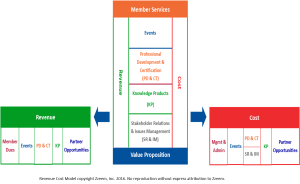How To Better Communicate Your Association’s Value To Members
By Paul Lansbergen, VP, Strategy, Innovation & Economics, Forest Products Association of Canada
Membership has its privileges, but how well do you communicate the value of association membership? If a member or prospective member asked you about the value of joining your association, do you have a convincing elevator pitch? In more detailed conversations you have time to dive deeper, but are you convincing in that situation too? Are your written materials clear and concise on the value of membership?
Those questions formed the essence of a session I led at the recent CSAE National Conference. Participants learned steps to identify components of a membership value proposition, received guidance on how to articulate, calculate, communicate, and evaluate a membership value proposition and were given suggestions on how to differentiate themselves from the competition.
At the beginning of the session, participants were asked if they had a membership value proposition. Only a few hands went up – maybe 10% of the room. Unfortunately, this is not a surprising result.
A Membership Value Proposition (MVP) statement explains what your members can expect to receive through their membership in your association. It explains why members should be members! Without a clear and well-communicated MVP, you are vulnerable to losing members.
Your MVP is derived from the activities within your business model (see Figure 1 below). Associations vary in their business model. Not everyone will be active in each area. The more of these measures you take, the more balanced your business model and potential MVP.
- Member Services – Affinity programs or other elements not outlined below
- Events – Conferences and similar offerings. The value can be a mix of content and networking.
- Professional Development and Certification – For members or a broader audience.
- Knowledge Products – These could be a variety of tools, reports, guidance, newsletters, etc.
- Stakeholder Relations and Issues Management – The staple for advocacy associations. The challenge here is exclusivity. If it is available to everyone, then non-members can get a free ride.
To articulate a membership value proposition, all of us face varying degrees of competition from the internet and social media. It is so easy for anyone to find information on the internet and create or join communities on social media. So, play close attention to the exclusive value you generate for your members. Also, tailor your MVP to different member cohorts as applicable.
Many associations qualitatively calculate their value proposition, or elements thereof, by using testimonials or describing value generation Be strategic in soliciting testimonials so that the quotes, and to whom they are attributed, will resonate with your target audience. Be clear in how you describe value generation – use action oriented language and indicate why it matters. This is necessary, but not sufficient, to be truly successful in communicating value.
Very few associations take the next step of quantitatively calculating their value proposition. The moral obligation to belong to an association is on life support. We have to show value – real and demonstrable value. Here are some tips on how to do just that:
- Don’t rely on a staff-only process – Validate with members to gauge how they value your activities.
- Quote third-party valuations – These add credibility.
- If estimating, be conservative – Exaggerating can undermine your credibility.
- Commission an independent review – Not a full audit, but just to show a reasonable process was used to arrive at the result.
- Tangibles are easier. Don’t forget about the intangibles.
Now that we have a good articulation of the value we generate and we have done our best to calculate that value, we need to communicate it. The objective is not only to retain your members, but to turn them into Member Recruitment Evangelists. You want them to be good ambassadors for you. Be clear, crisp, and concise. Everyone is busy and you need to cut through the clutter. Tell your members frequently, but use your judgement on how often you communicate with them. Also, consider their receptivity of your language – is it too blatant or too subtle? Tailor your communications to different member cohorts – the medium, messaging, and value components.
Association presence can represent value, but there are some considerations. Being seen might not have a specific or immediate value, but members may want to see you working on projects and achieving results. For advocacy, there is a balance between the number of meetings and getting results. Be cognizant of that. For promotion, speaking at conferences, advertising or other activities, show reach and measurable impact. The good thing about the internet and social media is that anyone can have a much bigger presence on a shoestring budget. However, you must not forget to be strategic.
A good practice is to evaluate your membership value proposition periodically. Seek feedback from members, prospective members, and expiring members. Leverage your network within the CSAE and consult your peers. The CSAE Bookstore and Library also have good resources. If you have it within your budget, commission a professional evaluation.
Identify your competition, whether it be other associations or online resources and communities. Compare value propositions to highlight your strengths and address your weaknesses. Depending on the nature of your competition, consider collaborating instead of competing.
Best of luck and remember to be clear, concise, and highlight the exclusive value that you generate!


